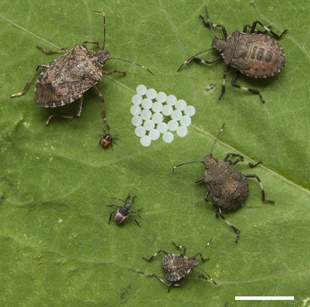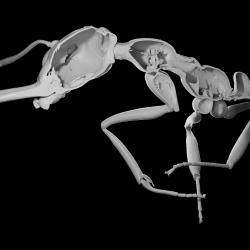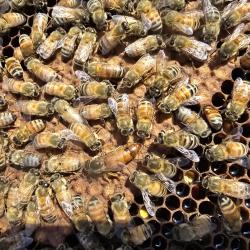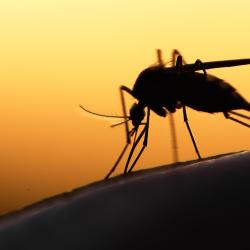A Fast First Step Toward Defeating Stink Bugs
Investigators at the University of Maryland School of Medicine’s Institute for Genome Sciences and the University of Maryland Department of Entomology have used a new strategy to quickly sequence genes activated throughout the life cycle of the invasive brown marmorated stink bug. Their findings, which could lead to new ways to control this abundant and costly pest, were published online August 29 in the journal BMC Genomics.
The brown marmorated stink bug, Halyomorpha halys, is an invasive pest of the mid-Atlantic region of the United States, which has caused millions of dollars of damage to a wide range of crops. It is also a pervasive nuisance to homeowners, invading gardens and overwintering indoors. There are few treatments to deter its damage or slow its ability to spread. Growers consider it the region’s most important pest, and many have tried desperate measures, including the increasing use of broad-spectrum pesticides. Until now, there has been little genetic information to aid researchers seeking more effective ways to control this troublesome invader.
With funding from the United States Department of Agriculture’s National Institute of Food and Agriculture (USDA-NIFA) Specialty Crop Research Initiative (SCRI), the Maryland scientists developed a way to skip the time-consuming process of breeding genetically identical individual animals in the laboratory, which is normally a first step in analysis of new genomes. Instead the researchers were able to sequence and analyze all of the genetic variants that arose in their population of stink bugs, and to do so at all points in the insects’ life cycles, from the egg stage through late adulthood.
“Rather than spending months or even years inbreeding insects in the laboratory in order to simplify the genetic analysis, this study demonstrates a new approach that analyzes a genetically diverse population of insects,” says Professor Leslie Pick, chair of the UMD Entomology Department, who guided the research. “This is the first step in our ongoing work to develop a pest control strategy that employs molecular genetic techniques to manage the stink bug invasion without affecting other, potentially beneficial insects.”
With this information in hand, researchers can develop new insights into the original stink bug invasion in Allentown, Pennsylvania and subsequent invasions throughout the U.S. The data can also aid in the development of novel pest management agents.
“We are excited to identify highly abundant bacterial genes with properties suggesting that they are functional parts of the stink bug genome,” says Julie Dunning Hotopp, an associate professor of microbiology and immunology at the University of Maryland School of Medicine’s Institute for Genome Sciences (IGS), and the paper’s senior author. “These genes may be novel targets in identifying a biocontrol mechanism.”
The brown marmorated stink bug is “a devastating pest of fruit and vegetable crops,” said U.S. Department of Agriculture entomologist Tracy Leskey, who directs the stink bug control project which funded this study. “It is going to require multiple approaches to reduce the threat. These results provide important ground work to develop targeted biological control agents for this exotic bug that has invaded the landscape.”
The project was supported by a grant from the United States Department of Agriculture-National Institute of Food and Agriculture (USDA-NIFA) Specialty Crop Research Initiative (SCRI) #2011-51181-30937.The content of this article does not necessarily reflect the views of the USDA.
Media contacts:
Sarah Pick, University of Maryland School of Medicine spick@som.umaryland.edu, 410-707-2543
Heather Dewar, UMD College of Computer, Mathematical and Natural Sciences hdewar@umd.edu, 301-405-9267
The research paper, “Rapid transcriptome sequencing of an invasive pest, the brown marmorated stink bug Halymorpha halys,” Panagiotis Ioannidis, Yong Lu, Nikhil Kumar, Todd Creasy, Sean Daugherty, Marcus C Chibucos, Joshua Orvis, Amol Shetty, Sandra Ott, Melissa Flowers, Naomi Sengamalay, Luke J Tallon, Leslie Pick and Julie C Hotopp was published online August 29, 2014 in BMC Genomics.
About the Institute for Genome Sciences
The Institute for Genome Sciences (IGS) is an international research center within the University of Maryland School of Medicine. Comprised of an interdisciplinary, multidepartment team of investigators, the Institute uses the powerful tools of genomics and bioinformatics to understand genome function in health and disease, to study molecular and cellular networks in a variety of model systems, and to generate data and bioinformatics resources of value to the international scientific community. www.igs.umaryland.edu
About the University of Maryland College of Computer, Mathematical, and Natural Sciences
The College of Computer, Mathematical, and Natural Sciences at the University of Maryland educates more than 7,000 future scientific leaders in its undergraduate and graduate programs each year. The college’s 10 departments and more than a dozen interdisciplinary research centers foster scientific discovery with annual sponsored research funding exceeding $150 million. www.cmns.umd.edu








